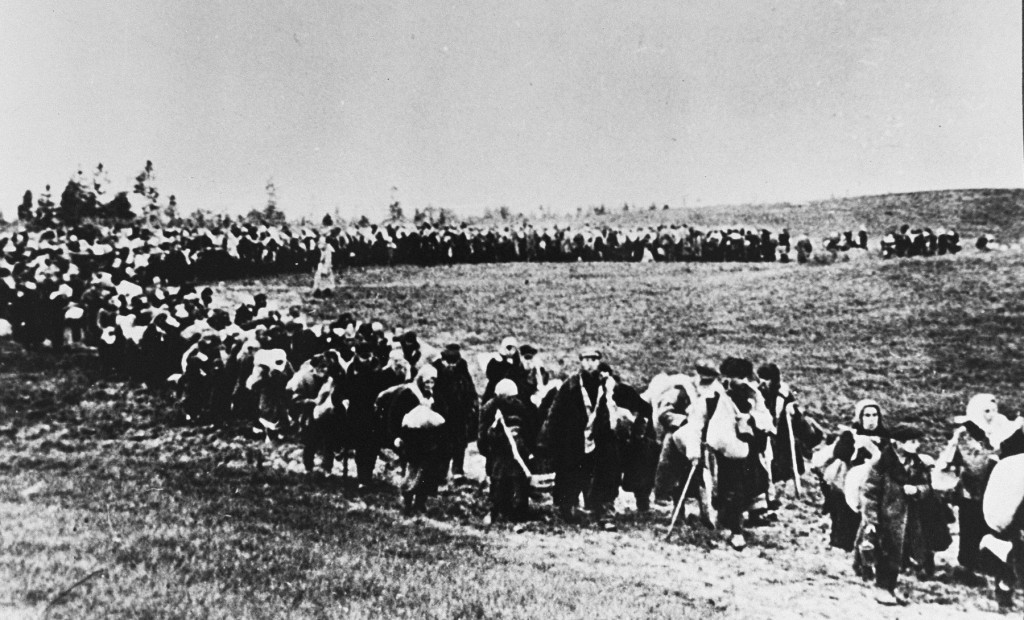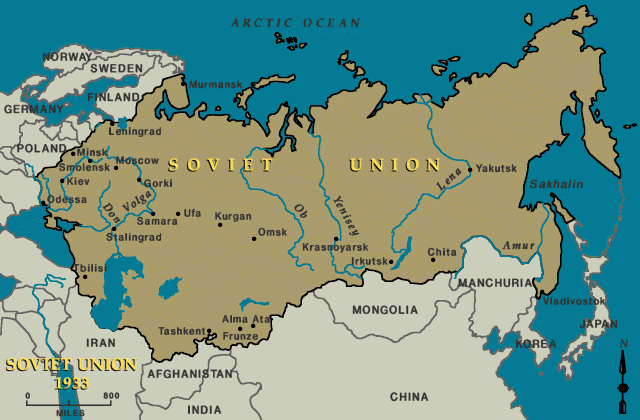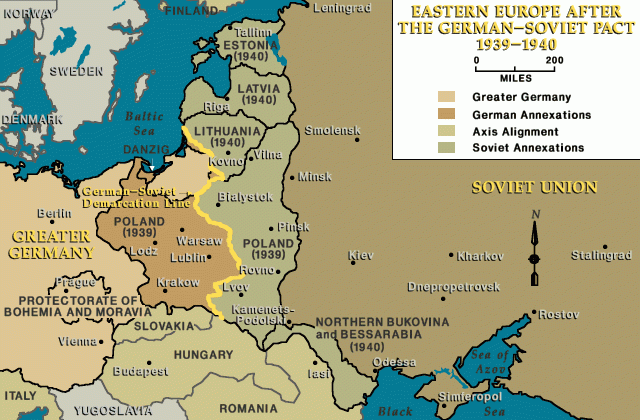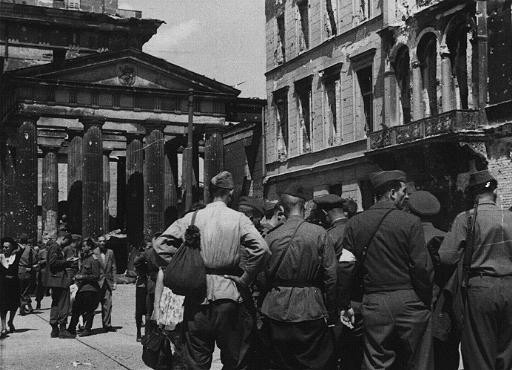
The Eastern Front: The German War against the Soviet Union
Nazi Germany and its allies invaded the Soviet Union on June 22, 1941. They quickly conquered large expanses of Soviet territory. German forces waged a “war of annihilation” against the Soviet Union and its peoples, killing millions of civilians. However, the Soviet armed forces eventually pushed the German military back and finally conquered Berlin in spring 1945. Often referred to as the “eastern front,” the German-Soviet theater of war was the largest and deadliest of World War II.
Key Facts
-
1
Adolf Hitler always planned to destroy the Soviet Union and to establish Lebensraum (living space) for the German people in Soviet territory.
-
2
Nazi Germany waged a “war of annihilation” against the Soviet Union that aimed to kill tens of millions of civilians. The Nazi “Final Solution” policy began with the systematic murder of Jews behind the eastern front.
-
3
Nazi Germany’s fighting and losses on the eastern front made it vulnerable to Allied invasions in Italy and France, leading to its total defeat.
The Soviet Union (USSR)

The Union of Soviet Socialist Republics (USSR) was formally established as a state in 1922. The Soviet Union—as it is often called—was a communist dictatorship based in Moscow. During World War II, the USSR was ruled by dictator Josef Stalin.
The Soviet Union was the result of the collapse of the Russian Empire and of the Russian Civil War (1917–1922). In February 1917, a popular revolution ousted the Russian tsar. The imperial regime was replaced with a provisional government. This revolution was followed by a coup that fall in which Vladimir Lenin and the Bolshevik Party seized power. In 1918, the Bolshevik Party was renamed the Communist Party. The Bolshevik coup led to a civil war that resulted in Communist control over most of the former Russian Empire. Soviet territory included the countries of Russia, Ukraine, and Belarus (Belorussia), among others.
The USSR actively sought to foment a world communist revolution in the name of the international working class. There were communist movements in nearly every industrialized country of the world. Many of these movements looked to the Soviet Union, then the only communist state, for leadership. The Communists aimed to eliminate all national, social, and economic distinctions between people. They also sought to abolish religious institutions. Since powerful elites within a society could not be expected to give up control voluntarily, the Communists advocated a violent revolution. After World War I, there were violent communist uprisings in Germany, as well as some other European states. Consequently, the Soviet Union was seen as a grave threat throughout the world, especially by members of established religions and the middle and upper classes, supporters of liberal democracy, capitalists, nationalists, and fascists.
The Soviet Union in the Nazi Worldview
From the founding of the Nazi movement in Germany, the Soviet Union was portrayed as an enemy with which a showdown was inevitable. The Nazi view of the Soviet Union was based on three tenets of Nazi racist ideology.
- Hitler saw the lands of the Soviet Union as the Germans’ destined Lebensraum (“living space”). He believed that Germany had to conquer these lands and populate them with Germans in order for the German “race” to win the constant battle for survival between the races.
- The Nazis maintained that Jews had created Bolshevik communism and were using it to gain world domination. Consequently, they often referred to communism as “Judeo-Bolshevism.” The Nazis viewed conquering the Soviet Union as a necessary step towards destroying Jewish influence in the world.
- The Nazis believed that the Slavs and other ethnic groups in the Soviet Union were racially inferior and by nature enemies of the German “race.”
For the first six years of Nazi rule, Nazi propaganda viciously attacked the Soviet Union. In private, Hitler spoke repeatedly of a future conflict. Nevertheless, in 1939 Nazi Germany embarked on a temporary strategic policy of cooperation with the Soviet Union. This temporary reversal reflected Hitler's tactical decision to secure his eastern flank while Germany destroyed Poland and defeated Britain and France.
German-Soviet Relations, 1939–1941

During the summer of 1939, Imperial Japan and the Soviet Union were fighting an undeclared war in Manchuria. In August of that year, Stalin welcomed the German offer of a pact. Like Hitler, Stalin wanted to avoid involvement in a two-front war. In addition, he hoped that war between Germany, Great Britain, and France would weaken all three nations and leave them vulnerable to communist uprisings directed and supported by the Soviet Union.
On August 23, 1939, Nazi Germany and the Soviet Union signed the German-Soviet Pact. This agreement is also known as the Molotov-Ribbentrop Pact (named after the two foreign ministers who negotiated it). The pact had two parts, one public and one secret. The public part was a non-aggression pact in which the two countries promised not to attack each other for ten years. And in a secret protocol, the signatories divided eastern Europe into German and Soviet spheres of influence and agreed to partition Poland.
The German-Soviet Pact enabled Germany to attack Poland on September 1, 1939, without fear of Soviet intervention. Two days later, Britain and France—having guaranteed to protect Poland’s borders five months earlier—declared war on Germany. These events marked the beginning of World War II.
In accordance with the pact’s secret protocol, the Soviet army occupied and annexed eastern Poland in the autumn of 1939. On November 30, 1939, the Soviet Union attacked Finland. After a four-month war, the Soviets annexed Finnish borderlands, particularly near Leningrad (St. Petersburg). In the summer of 1940, they occupied and incorporated the Baltic states and seized the Romanian provinces of Northern Bukovina and Bessarabia.
Germany Prepares to Attack
By July 1940, Germany had occupied Denmark, Norway, Belgium, and the Netherlands. It had also defeated France. Hitler decided the time had come to vanquish the Soviet Union, even though Great Britain continued to fight. Hitler and his military leaders believed Germany would swiftly defeat the Soviet Union and would then have an unassailable position on the European continent.
German diplomats worked to secure Germany’s ties in southeastern Europe. Hungary, Romania, and Slovakia all joined Germany and Italy in the Axis alliance in November 1940. On December 18, 1940, Hitler signed Directive 21 (code-named Operation Barbarossa). This was the first operational order for the invasion of the Soviet Union. During the spring of 1941, he initiated his eastern European allies into the invasion plans.
The German Invasion of the Soviet Union
Hitler and his military advisers planned Operation Barbarossa as a Blitzkrieg (lightning war) that would defeat the Soviet Red Army in a matter of weeks. Originally, the invasion was planned to begin in May. It was postponed for a month so that Germany could secure its southern flank by conquering Greece and Yugoslavia.
German forces invaded Soviet-held territories on June 22, 1941, less than two years after the German-Soviet Pact was signed. Operation Barbarossa is considered the largest military operation in the history of warfare. Three army groups, including more than three million German soldiers, were soon joined by more than half a million troops from Germany’s allies (Finland, Romania, Hungary, Italy, Slovakia, and Croatia). They attacked the Soviet Union across a broad front, from the Baltic Sea in the north to the Black Sea in the south.
For months, Stalin had refused to heed warnings from Britain and the United States that Germany was about to invade the Soviet Union. Germany thus achieved almost complete tactical surprise and the Soviet armies were initially overwhelmed. Millions of Soviet soldiers were encircled. They were cut off from supplies and reinforcements, and forced to surrender. After just three weeks of fighting, Hitler and his military advisers were confident that complete victory over the Soviet Union was at hand.
War of Annihilation
Hitler and the German military planned the campaign against the Soviet Union as a “war of annihilation” (Vernichtungskrieg) against both the “Judeo-Bolshevik” communist government and Soviet citizens, especially Jews. Leaders of the Wehrmacht (Germany’s armed forces) instructed soldiers to ignore the rules of warfare for protecting civilians and to deal with all enemies “without mercy.”
German planners decided that the German army would live off the land rather than be provisioned from Germany. They recognized that this policy would cause tens of millions of civilian inhabitants to starve to death.
In retaliation for acts of resistance, the Wehrmacht instituted collective punishment of civilians. This frequently involved burning down entire villages and murdering their inhabitants.
Mass Shootings behind the Eastern Front
In preparation for the war of annihilation, officials of the Army High Command (Oberkommando des Heeres, OKH) and the Reich Security Main Office (Reichssicherheitshauptamt, RSHA) negotiated arrangements for the deployment of SS Einsatzgruppen to conduct mass shootings of Jews, Communists, and other persons deemed to be dangerous to the establishment of long-term German rule on Soviet territory. Einsatzgruppen were special task forces of the Security Police (Sicherheitspolizei, Sipo) and the Security Service (Sicherheitsdienst-SD). Often referred to as "mobile killing units," they operated immediately behind the front lines. Together with other units of the SS and police, and supported by the Wehrmacht and local auxiliaries, the Einsatzgruppen shot to death well over half a million civilians by the end of 1941. Jewish men, women, and children made up the vast majority of the victims. The systematic mass murder of Jews during the invasion of the Soviet Union marked the beginning of Nazi Germany’s “Final Solution” policy of annihilating the Jews in Europe.
Mass Murder of Soviet POWs
Germany’s annihilation policies included Soviet soldiers who had surrendered. The Wehrmacht enclosed millions of Soviet POWs in make-shift camps with little or no shelter, food, or water. Starvation and epidemics quickly took their toll. The Wehrmacht also turned over hundreds of thousands of Soviet POWs to the SS. The SS executed the Soviet POWs or worked them to death in concentration camps. By February 1942, less than eight months after the start of the invasion, two million Soviet soldiers had died in German captivity.
The Front Stalls
By early September 1941, German forces had reached the gates of Leningrad in the north. They had taken Smolensk in the center and Dnepropetrovsk in the south. German units reached the outskirts of Moscow in early December. But with the onset of winter, the German advances stalled.
After months of campaigning, the German army was exhausted. Having expected a rapid Soviet collapse, German planners had failed to equip their troops for winter warfare. Moreover, the speedy German advance caused the forces to outrun their supply lines, which were vulnerable due to the great distances involved (Moscow is almost 1,000 miles east of Berlin).
In December 1941, the Soviet Union launched a major counterattack against the center of the front, driving the Germans back from Moscow in chaos. The Germans repulsed subsequent Soviet offenses in the northern and southern areas of the front. But it took them nearly two months to stabilize the front east of the city of Smolensk. They then regrouped and planned to go on the offensive again.
The Blitzkrieg campaign failed to achieve its objective. Nevertheless, German leaders were still confident that the Soviet Union was on the verge of collapse. They assumed the country had nearly exhausted its resources. Further, they believed that the Soviet Union’s disgruntled citizens would not be willing to sacrifice their lives for Stalin’s regime. In fact, some people in the territories seized by the Wehrmacht at first welcomed the Germans as liberators.
But during the winter of 1941–1942, the Soviets evacuated factories east and massively increased production of planes, tanks, and other weapons. Great Britain and the United States supported these efforts with shipments of materiel. Meanwhile, German policies of mass murder gave credence to Stalin’s arguments that Soviet citizens’ survival depended upon repelling the German invaders. In addition, Red Army soldiers who retreated were executed by the NKVD, the Soviet secret police. Confronted with the prospect of starving to death in a German camp if they surrendered or facing a firing squad if they retreated, Soviet soldiers generally preferred fighting to the death.
The Eastern Front, 1942–44
1942–1943
In the summer of 1942, Germany and its allies launched a massive attack to the south and southeast toward the industrial center of Stalingrad on the Volga River and toward the oil fields of the Caucasus. German military leaders believed seizing the oil fields would cripple the Soviet war effort and ensure that Germany and Italy had sufficient fuel to pursue the offensive on all fronts and at sea. For Hitler, taking the city named for Josef Stalin would be a major psychological, as well as strategic, victory.
By September 1942, Germany had reached the peak of its military success. It dominated Europe from France in the west to the Volga River in the east; from the Arctic Circle in Norway to North Africa. In the three years since it launched World War II, Germany had not experienced a single major military defeat.
Then November brought two major reversals. On November 8, as German forces seemed on the verge of taking Stalingrad, British and American forces landed in North Africa. To confront them, Hitler transferred troops, armaments, and airplanes from the eastern front. On November 19, the Soviet army launched a massive counteroffensive against the German and Romanian forces trying to conquer Stalingrad. In less than a week, Soviet forces had surrounded their enemy, including the entire German Sixth Army. Two more months of fierce combat followed in which both sides took heavy casualties. The surviving German soldiers surrendered between January 31 and February 2, 1943.
The German defeat and the death or capture of a quarter million soldiers at Stalingrad shocked the German public and shook their faith that Germany would win the war. The campaign on the eastern front had massively depleted German manpower and weaponry. In the meantime, the western Allies’ bombing campaign was crippling German efforts to rearm and turning German cities to rubble.
1943–1944
In July 1943, the Germans launched one more major offensive at Kursk, in Russia. The Soviets were well aware of German plans and defeated the German forces in just a few days. At the same time, the western Allies landed in Sicily. Their arrival there forced the Germans to send troops to battle on a new front. From this point, German forces steadily retreated on the eastern front. They never again succeeded in resuming the offensive.
By the end of 1943, Soviet forces had pushed German forces out of most of Ukraine and virtually all of Russia and eastern Belarus (Belorussia). Shortly after the western Allies successfully landed in Normandy, France in June 1944, the Soviets launched another major offensive. In this successful campaign, the Red Army took control of the rest of Belarus (Belorussia) and Ukraine, most of the Baltic states, and eastern Poland. By August 1944, Soviet troops had crossed the German border into East Prussia (a German province located between interwar Poland and Lithuania).
The German Surrender
In January 1945, a new offensive brought Soviet forces to the Oder River, in Germany proper, about 100 miles from Berlin.
In mid-April 1945, the Soviet army launched its final assault on Nazi Germany. It captured Vienna on April 13 and encircled Berlin on April 21. On April 25, Soviet advance patrols met American troops at Torgau on the Elbe River in central Germany, effectively cutting the country in half. After more than a week of heavy fighting in the streets of Berlin, Soviet units neared Hitler's central command bunker. On April 30, 1945, Hitler committed suicide. Berlin surrendered to Soviet forces on May 2, 1945.

The German armed forces surrendered unconditionally in the west on May 8 and in the east on May 9, 1945. On May 9, the Soviet army entered Prague, the last major city still occupied by German units. The western allies proclaimed May 8, 1945, as Victory in Europe Day (V-E Day).
More people fought and died on Nazi Germany’s eastern front than in all other World War II campaigns combined.
Critical Thinking Questions
Investigate the number of civilian and military casualties suffered by the Soviet Union. What percentage of the population are these figures?
When Allied soldiers landed on the D-Day beaches on June 6, 1944, what was the status of the war on the eastern front? How far had the Soviet army moved westward?

